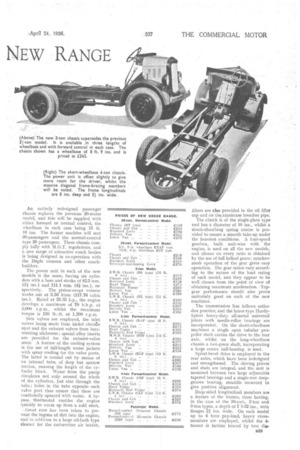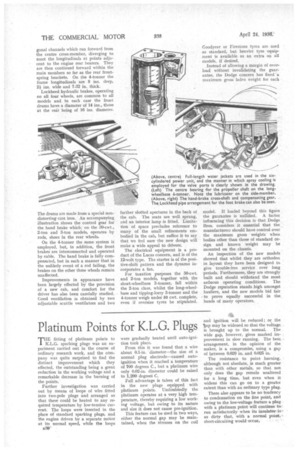DODGE ANNOUNCES A FINE NEW RANGE
Page 42

Page 43

Page 44

If you've noticed an error in this article please click here to report it so we can fix it.
INMay of last year, Dodge Brothers (Britain), Ltd., Mortlake Road, Kew Gardens, Surrey, introduced a new 4tonner designed in this country for use under British conditions, and having no American counterpart. So successful has this model proved, that the concern has now decided to continue this policy, and now announces an entirely
new range of goods vehicles ranging from 30 cwt. to 4 tons. In addition, a new passenger chassis is to be marketed.
All the new machines have been designed in this country. Furthermore, they are being built at the Kew works. An important feature of the design is the repositioning of the axles to give better load distribution. On the new 2-ton and 3-ton models, for example, the front axle has been moved back 7i ins. The length required behind the axle to accommodate the driver's cab is thus reduced and the load is carried farther within the wheelbase.
By this means the load on the tyres
and springs is reduced, also there is B28
likely to be less stress on the engine and transmission. Due to the shorter wheelbase, better turning circles are possible, and the new models should prove easily manceuvrable in heavy traffic and restricted areas. Compared with previous models the body capacities, are not reduced in any way.
The new range comprises a 30-cwt. model available in two wheelbase lengths of 10 ft. 4 ins. and 8 ft. 9 ins., respectively. Both are built with forward control, whilst the long-wheelbase .machine is also marketed in normalcontrol form. The new 2-tonner is to be supplied only with normal control, and two models are available, with wheelbases of 10 ft. 4 ins. and 12 ft. 6 ins.
Entirely superseding the old 2i-ton model, the new 3-tonner is produced in three types, all having forward control. The respective wheelbases are 8 ft. 9 ins., 10 ft. 4 ins. and 12 ft. 6 ins. Completing the range of good vehicles is the 4-tonner, in which improvements have been effected in the light of a year's operating experience. The appearance has been greatly enhanced by the provision of a new cab, and other minor modifications have been made. This model will continue in two wheelbase lengths of 9 ft. 4 ins. and 13 ft. 1 in., respectively.
An entirely redesigned passenger chassis replaces the previous 20-seater model, and this will be Supplied with either forward Or normal control, the wheelbase in each case being 13 ft. 10 ins. The former machine .will seat 26-passengers and the normal-control type 20 passengers. These chassis comply fully with M.O.T. regulations, and a new range of attractive coach bodies is being designed in co-operation With the Duple concern and other coachbuilders.
The power unit in each of the new models is the same, having six cylinders with a bore and stroke of 82.5 (3i ins.) and 111.1 mm. (41 ins.), respectively. The piston-swept volume works out at 3.56 litres (217.76 cubic ins.). Rated at 25.35 h.p., the engine develops a maximum of 70 b.h.p. at 3,000 r.p.rn., whilst the maximum torque is 150 Ib.-ft. at 1,200 r.p.m.
Side valves are employed, the inlet valves being made from nickel chrorte steel and the exhaust valves from heatresisting siIchrome ; special alloy inserts are provided for the exhaust-valve seats. A feature of the cooling system is the use of full-length water jackets with spray cooling for the valve ports. The latter is carried out by means of an internal tube, of deep but narrow section, running the length of the cylinder block. Water from the pump circulates not only around the whole of the cylinders, but also through the tube; holes in the tube opposite each valve port thus ensure that these are continually sprayed with water. A bypass thermostat enables the engine quickly to warm up from a cold start.
• Great care has been taken to prevent the ingress of dirt into the engine, a-nd in addition to a large oil-bath type cleaner for the carburetter air intake,
filters are also provided in the oil filler cap and on the,crankcase breather pipe.
The clutch is of the single-plate type and has a diameter of 10 ins., whilst a shock-absorbing spring centre is provided to ensure a smooth take-up under the heaviest conditions. A four-speed gearbox, built unit-wise with the engine, is used on all the new models, and silence on every ratio is obtained by the use of full helical gears; synchromesh operation of the gear gives -easy operation. The gear ratios vary according to the nature of the load rating of each model, and they appear to be well chosen from the point of view of obtaining maximum acceleration. Topgear performance should also prove uniformly good on each of the new machines.
The transmission line follows orthodox practice, and the latest-type HardySpicer heavy-duty all-metal universal joints with needle-roller. bearings are incorporated. On the short-wheelbase machines a single open tubular propeller shaft carries the drive to the rear axle, whilst on the long-wheelbase chassis a two-piece shaft, incorporating a large centre ball-bearing, is used.
Spiral-bevel drive is employed in the rear axles, which have been redesigned and strengthened: The driving pinion' and shaft are integral, and the unit is mounted between two large adjustable tapered bearings and a single-row deep. groove bearing, straddle mounted to give positive alignment.
Deep-sided longitudinal members are a feature of the frames, these having, in the case of the 30-cwt., 2-ton and 3-ton types, a depth of 7 1-32 ins., with flange. 2a ins. wide. On each model up to 4 tons pay-load, heavy cross. members are employed, whilst the 4tanner is further braced by two diar
gonal channels which run forward from the centre cross-member, diverging to meet the longitudinals at points adjacent to the engine rear hearers. They are then continued forward within the main members so far as the rear frontspring brackets. On the 4-tonner the frame longitudinals are 8 ins. deep, 2i ins, wide and 7-32 in. thick.
Lockheed hydraulic brakes, operating on all four wheels, are common to all models and in each case the front drums have a diameter of 14 ins., those at the rear being of 16 ins. diameter.
The drums are made from a special nondistorting cast iron. An accompanying illustration shows the control gear for the hand brake which, on the 30-cwt., 2-ton and 3-ton models, operates by rods, shoes in the rear wheels.
On the 4-tonner the same system is employed, but, in addition, the front brakes are interconnected and operated by cable. The hand brake is fully compensated, but in such a manner that in the unlikely event of a rod failing, the brakes on the other three wheels remain unaffected.
Improvements in appearance have been largely effected by the provision of a new cab, and comfort for the driver has also been carefully studied. Coed ventilation is obtained by two adjustable scuttle ventilators and two further slotted apertures in the back of the cab. The seats are well sprung, and an interior lamp is fitted. Limitation of space precludes reference to many of the small refinements embodied in the cab, but suffice it to say that we feel sure the new design will make a wide appeal to drivers'.
The electrical equipment is a product of the Lucas concern, and is of the 12-volt type. The starter is of the positive-shift pattern and the dynamo incorporates a fan.
For taxation purposes the 30-cwt. and 2-ton models, together with the short-wheelbase 3-tanner, fall within the 2-ton class, whilst the long-wheelbase and tipping-lorry 3-tonner and the 4-tonner weigh under 50 cwt. complete, even if oversize tyres be stipulated. Goodyear or Firestone tyres are used as standard, but heavier tyre equipment is available as an extra on all models, if desired.
Instead of allowing a margin of overload without invalidating the guarantee, the Dodge concern has fixed 'a maximum gross laden weight for each (Above, centre) Full-length water jackets are used in the sixcyllndered power unit, and the manner in which spray cooling is employed for the valve ports is clearly shown in the drawing. (Left) The centre bearing -for the propeller shaft on the longwheelbase 4-tonner. Note the lubricator on the side-member. . (Above, right) The hand-brake cross-shaft and compensating gear. The Lockheed pipe arrangement for the foot brake can also be seen.
model. If loaded beyond this figure the guarantee is nullified. A factor influencing this decision is that Dodge Bros. considers it essential that the manufacturers should have control over the maximum gross weights when bodies other than those of standard design and known weight may be mounted on the chassis.
An inspection of the new models showed that whilst they are orthodox in layout they have been designed to give trouble-free service over long periods. Furthermore, they are strongly built and should withstand the most arduous operating conditions. The Dodge reputation stands high amongst hauliers, and the new models bid fair to prove equally successful in the hands of many operators.




























































































